Anjum Anand's Indian vegetarian recipes for biryani, burgers and more
Updated , first published
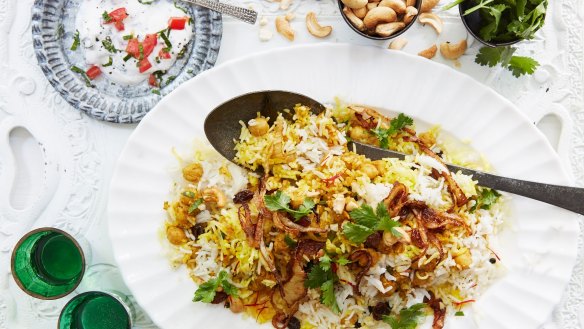
London-based chef and food writer Anjum Anand explains her vegetarian lifestyle and shares six Indian-inspired recipes to spice up your next meat-free Monday feast.
Why is your family predominantly vegetarian?
My husband and his family are Jains. This is an Indian religion where they believe no harm should come to animals so his family has always been vegetarian. My children are also vegetarian so the house is meat-free and all meals are vegetarian.

What health benefits do you feel when eating a vegetarian diet?
I am a fan of ayurveda – a diet that consists of freshly prepared vegetarian meals and believes vegetarianism is the ideal way of living. Also, there is a lot of research saying that a vegetarian diet increases your life expectancy. The benefits of eating in a certain way are not immediate; it is remaining in good health over time.
What are your favourite vegetarian dishes?
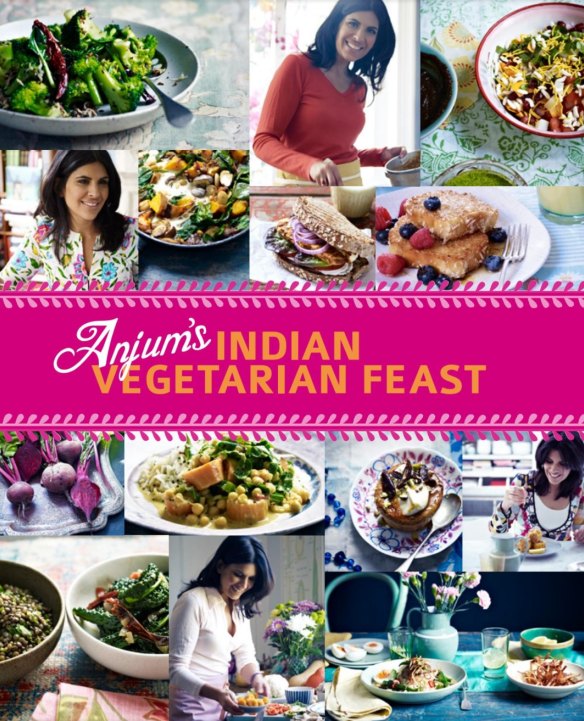
I am a big fan of all paneer dishes and lentils are one of my favourite ingredients. I also love most Asian food and they make delicious vegetarian dishes.
What would you recommend people do to make their vegetarian dishes more interesting?
Vegetarian food can be more challenging to cook than meat or fish and at times it may need a little extra help, however vegetarian food certainly isn't boring. There are so many delicious ways to cook vegetarian food; using Indian spices and Asian flavourings are my personal favourite. Ginger, garlic, chilli, soy, miso, mirin, coconut, onions, fresh herbs, tomatoes, lemon, spices and nuts will all add extra oomph to vegetarian dishes. Also, dairy products like cheese or seasoned Greek yoghurt can add a lovely contrast to vegetarian meals.
What are your favourite ingredients to use in your cooking?
I love meaty vegetables like mushrooms and eggplants as well as green vegetables such as broccoli and kale. I like wholegrains and will cook up brown basmati rice, farro or make whole-wheat flatbreads with different grains. I like variety so will try and cook different vegetables and vegetarian protein for the family every day and opt for different cuisines as well, so no one gets bored.
There is a perception that Indian food is all about meat curries. Is this true?
Probably half the Indian population is vegetarian. Indians have practiced vegetarianism for hundreds of years so the vegetarian side of the cuisine is very well developed and balanced, making it one of the best ways to enjoy a vegetarian diet. A typical plate would have some seasonal vegetables, a vegetable protein and a carbohydrate.
What are the most popular vegetarian dishes in India?
This varies from region to region. But across the country, bean and lentil curries are probably the most popular. Paneer, a fresh white cheese, is also very popular in the north.
Why do most Indians have a vegetarian diet?
Thousands of years ago ayurvedic doctors heavily influenced the cuisine. These doctors believed a vegetarian diet was healthier (for most, unless you were very weak, in which case meaty broths were prescribed). Also, Hindus and Jains believe everything has a living soul and if you kill a soul that is bad for you and your karma. Lastly, meat was very expensive so was mostly a treat eaten twice a week at most.
Chickpea biryani
This looks like a really long recipe and a biryani is definitely involved which is what makes it special. Having said that, I had some leftover pilaf rice and whipped up the chickpea filling in just 20 minutes. I skipped the crispy onion topping and layered it within five minutes. I then came home in the evening, reheated it for 20 minutes and dinner was ready.
INGREDIENTS
large pinch of saffron
4 tbsp milk
handfuls of raisins and roasted cashew nuts, crispy browned onions and fresh chopped coriander for garnish (use as many or as few of these, the more the better)
salt and freshly ground black pepper to taste
20g butter for assembling
For the rice
1 tbsp vegetable oil
2 tbsp ghee
400g basmati rice
750ml water
5 cloves
5 green cardamom
2.5cm cinnamon
1 bay leaf
2 small onions, finely sliced
For the chickpeas
3-4 tbsp vegetable oil
2 x 400g cans of chickpeas, drained and rinsed
2 small-medium onions, finely chopped
4 fat cloves garlic, grated into a fine paste (about 2 tsp)
1 tsp ginger paste (fresh is best)
¼ to ½ tsp red chilli powder or to taste
2 tsp coriander powder
2 tsp cumin powder
½ tsp turmeric powder
2 tsp garam masala powder
4 tbsp yoghurt
2 medium tomatoes, roughly chopped
3 tbsp each chopped mint
3 tbsp chopped coriander
raita to serve
METHOD
1. Make the rice: Wash the rice really well in several changes of water or until the water runs clear. Leave to soak.
2. Heat the oil and ghee in a large, heavy bottomed saucepan which has a lid. Add the whole spices and cook for 30 seconds or until aromatic. Add the onions and half a teaspoon salt and cook until soft, stirring occasionally, then turn the heat up and cook until golden. Meanwhile, drain the rice and add it into the golden onions. Stir well over a high heat to dry off any excess water and coat the rice in the oil for about two to three minutes.
3. Add the water to the pan, taste and season well. The water should taste a little salty or the rice will be a bit flavourless. Bring to a boil then cover and turn the heat right down. Cook undisturbed for seven to eight minutes then test a grain, if it is done, take off the heat and set aside for 10 minutes, if not, leave to cook another minute or so. Once steamed, spoon some rice onto some open plates to prevent overcooking. You can use this pot for the final assembly.
4. For the chickpeas: Blend together the tomatoes and yoghurt or chop the tomatoes and whisk the yoghurt.
5. Heat the oil in a medium-large sized saucepan. Add the onion with a good pinch of salt and cook until really soft, then turn the heat up and cook until properly golden.
6. Add the ginger and garlic and cook gently for 30 to 40 seconds or until the garlic is golden and smells cooked. Add the powdered spices and more seasoning with a splash of water and cook until the water has evaporated.
7. Add the tomato and yoghurt mix and cook, over a moderate to high flame, stirring constantly until the mixture comes to a boil and then reduces to a paste. This stops the yoghurt from splitting. Turn the heat down a little and cook until the paste darkens. Add the chickpeas and a good splash of water and bring back to the boil, taste, and adjust seasoning. Simmer for four to five minutes. Add the mint and coriander and take off the heat. There should be some liquid in bottom of the pan.
8. To assemble: Heat the milk and add the saffron, soak for 15 minutes.
9. When you are ready to serve, break up the butter into cubes and place half on the bottom of your pan. If your pan is quite wide, you can make this in three layers, if it is narrow then maybe do five (i.e. rice, chickpea, rice, chickpea, rice). So, cover with half/third of the rice, drizzle with half/third of the saffron water. Layer whole or half the chickpea masala and top with the rice, saffron etc. and keep going until all the layers are done. Top with the saffron drizzle, raisins and cashews.
10. Cover with a tight fitting lid and place on a low heat for 20 minutes or until it is steaming. You can leave this, off the heat, for 20 minutes now and it will stay hot.
To serve: spoon onto a platter, scatter crispy onions and coriander for garnish and serve with raita.
Serves 6
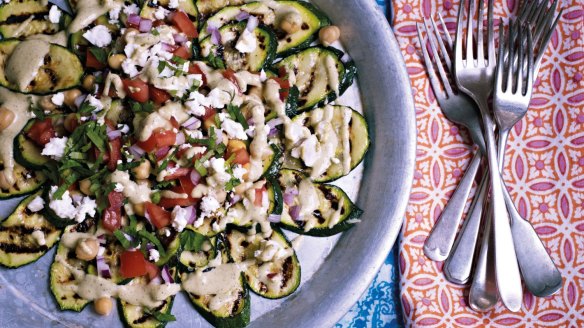
Grilled zucchini carpaccio, chickpea salsa, pistachio dressing
This lovely, light dish started out simply as a simple zucchini carpaccio on a summer evening when I had some friends coming over. It has since morphed into a more substantial dish and one that works equally well as a light salad in itself or as a platter to be enjoyed by friends with some more substantial foods.
INGREDIENTS
For the salad
4 large zucchinis (a mix of green and yellow, if possible)
olive oil, to brush
400g can chickpeas, drained well and rinsed
1½ tbsp lemon juice, or to taste
1 tbsp roasted ground cumin
1 small tomato, finely chopped
⅓–½ small red onion, finely chopped
salt, to taste
30g coriander (leaves and roots), chopped
75g–100g feta cheese
For the pistachio dressing
¾–1 tbsp red or white wine vinegar, or to taste
1 small garlic clove, peeled
15g pistachios (roasted is fine)
2½ tbsp extra virgin olive oil
¼ tsp coarsely ground black pepper, or to taste
¼ tsp castor sugar
METHOD
Heat a char-grill pan until quite hot. Slice the zucchinis on the diagonal into thin slices, no more than half a centimetre. Oil the slices, place on the grill pan in a single layer and cook, undisturbed, for three minutes, or until the base has well-charred lines. Turn and repeat on the other side. Repeat with the remaining zucchinis. Transfer to a plate as you cook each batch.
As you keep an eye on the grill, stir together the chickpeas, lemon juice, roasted cumin, tomato and red onion and season to taste.
Blend together all the ingredients for the dressing with two tablespoons water until smooth; I use a good stick blender, but a mortar and pestle will also work. Adjust the seasoning and vinegar to taste and keep aside.
To assemble, place the zucchini slices on plates or a platter, slightly overlapping at the edges. Drizzle with the dressing. Mix the coriander into the chickpeas, scatter them over with the feta cheese and serve.
Serves four as a side dish or 2 as a light lunch
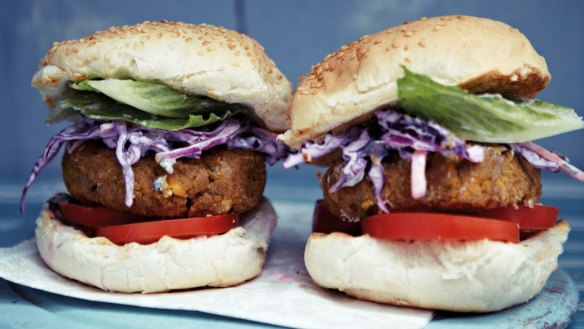
Chickpea burgers and Indian purple coleslaw
These burgers are spicy and deeply satisfying. Put aside any preconceptions of bland, mass-produced bean burgers, these are so much more. The coleslaw adds vivacity with its texture, freshness and tanginess. The patties also work well made into kebabs and rolled into a wrap with the coleslaw, tangy herb chutney and garlic yoghurt.
INGREDIENTS
For the burgers
4 tbsp vegetable oil
1½ tsp cumin seeds
1 small onion, finely chopped
2 tsp peeled, finely chopped ginger
4 garlic cloves, peeled and finely chopped
2 tsp ground coriander
1½ tsp ground cumin
1½ tsp garam masala
1½ tsp dried pomegranate powder* (optional but really delicious)
1½ tsp chilli powder
salt, to taste
2 x 400g cans chickpeas, drained and rinsed
2 slices of wholemeal bread, processed into breadcrumbs
For the purple coleslaw
50g shredded red cabbage
20g finely sliced red onion
30g finely sliced carrots
large handful of chopped coriander leaves
80g mayonnaise (light is fine)
30g Greek yoghurt
2 tsp lemon juice
freshly ground black pepper
To serve
4 large, or 6 small, burger buns (I like those with sesame seeds)
a few crisp lettuce leaves
1 large vine tomato, sliced
METHOD
1. For the burgers, heat two tablespoons of the oil in a non-stick saucepan. Add the cumin seeds and cook for 10 to 20 seconds, or until they have darkened a little. Add the onion and cook until golden and the edges are beginning to brown. Add the ginger and garlic and cook gently for a minute or until the garlic no longer smells raw. Add the spices, salt and a splash of water and cook down until dry again.
2. Add the chickpeas and cook for three to four minutes, or until most of the moisture in the pan has dried off. Taste and adjust the seasoning. Pour just over three-quarters of the contents of the pan into a blender with the breadcrumbs, and blend until smooth. Lightly crush the remaining chickpeas in the saucepan, scrape the blended mixture back into the pan and mix well.
3. Mix together all the ingredients for the coleslaw and season to taste.
4. When you are ready to eat, heat the remaining oil in a non-stick frying pan. Form the chickpea mixture into four to six patties, making sure the edges are smooth. Place in the pan and cook over a gentle flame for six to eight minutes, turning once, until both sides are lightly browned.
5. Meanwhile, lightly toast the buns. Assemble the burgers with the coleslaw, lettuce and tomato.
Serves 4-6
*Pomegranate powder is available from Indian supermarkets, substitute with dried mango powder or use lemon juice to taste.
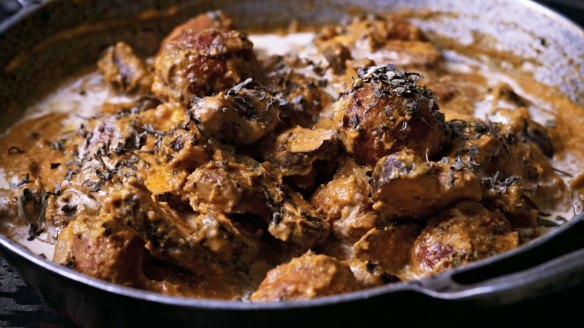
Paneer kofta and shiitake mushroom curry
This is definitely a special occasion dish as it is elegant as well as delicious, and worth the effort if you have people coming around. Alternatively, I like to stuff these balls with a raisin and a pistachio each, which also works really well in this dish.
INGREDIENTS
350g paneer (place in just-boiled water as you work if it is store-bought)
small handful of chopped fresh coriander
12 medium-sized shiitake mushrooms, thickly sliced or stalks removed and halved
oil to fry
For the sauce
8 tbsp vegetable oil
3 black cardamom pods
2 large onions, sliced
4 fat garlic cloves, peeled and finely grated
25g ginger, peeled and finely grated
4 large tomatoes, quartered
2 tbsp tomato puree
salt to taste
½-¾ tsp red chilli powder
1 tbsp coriander powder
1¾ tsp cumin powder
⅓ tsp turmeric powder
2 tsp garam masala powder
50g cashew nuts, soaked
5-6 tbsp double cream
1 tsp dried fenugreek leaves
fresh coriander to garnish
METHOD
1. Heat the oil in a large non-stick saucepan. Add the black cardamom pods and onions and cook until they are well browned. Add the ginger and garlic pastes and cook until they are lightly colouring. Add the tomatoes, tomato puree, remaining spices and seasoning; cook over a moderate heat, stirring occasionally, until all the water has boiled off and the paste releases oil, around 15 to 20 minutes. Cook the paste for a few minutes over a moderate to high heat, stirring constantly to get a better depth of flavour. Add a splash of water and blend the sauce to a fine puree. Pour back into the pan, add enough water for the consistency of single cream, bring to a boil, cover and simmer for six to seven minutes.
2. While the curry is cooking make the koftas. Break up and crumble the paneer until it is fine and with the heel of your hand knead this until it is even finer. Work the dough until when you squeeze a bit together, it holds, the more you work it the smoother it becomes and the warmth and moisture of your hand will get you there. Add half a teaspoon salt and the coriander, and form into large marble-sized balls.
3. Add enough oil to come five centimetres up the sides of a small saucepan and heat to around 180C. Test the oil by dropping a small amount of the mixture into the oil, it should sizzle immediately but not colour straight away. Add enough koftas so that the pan is not over-crowded, cook turning halfway until they are a deep golden, drain and place on paper towel and repeat with the remaining koftas. Remove most of the remaining oil from the pan, leaving in around one to two tablespoons, add the whole mushrooms, season lightly and sauté for four to five minutes. Set aside.
4. Once the curry is done, add the cashew nut paste and cream, bring to a gentle simmer – the consistency should be of a light cream. Add the koftas and mushrooms, bring back to a boil, cover and simmer gently for five minutes. Taste and adjust seasoning.
To serve, sprinkle over the dried fenugreek leaves and garnish with a swirl of cream and a little fresh coriander.
Serves 5-6
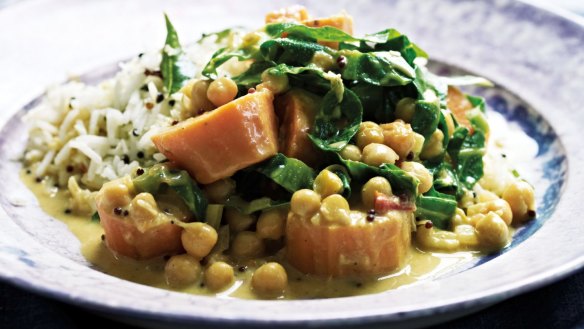
Keralan coconut curry
Kerala is the land of coconut and there are few meals where it won't feature in some way. My first taste of one of their most famous vegetarian coconut curries, called ishtu, was not in Kerala but another Indian city. The light coconut curry was delicately flavoured, mostly with black peppercorns and a mixture of vegetables which all retained their flavours. Served with simple rice, it was healthy and hearty. This is another Kerala-inspired coconut curry, full of tropical flavours and southern spices. Again, perfect with rice or fluffy naan to soak up the sauce. Here I have used sweet potatoes, chickpeas and seasonal greens. Serve with rice, naan or paratha flatbread.
INGREDIENTS
For the vegetables
400g sweet potatoes, peeled, cut into 3cm chunks
100g shredded greens or spinach, washed
400g can chickpeas, drained and rinsed
For the curry
4 tbsp vegetable oil
1 tsp mustard seeds
1 onion, finely chopped
3–5 green chillies, whole but pierced with the tip of a knife
25g root ginger, peeled weight, finely chopped
5 fat garlic cloves, peeled and finely chopped
2 small tomatoes, chopped
salt, to taste
½–⅔ tsp turmeric
2 tsp ground coriander
¾–1 tsp ground cumin
400ml creamy coconut milk
½–¾ tsp tamarind paste, dissolved in a little hot water, to taste
¾ tsp garam masala, or to taste
knob of coconut cream
lots of freshly ground pepper
METHOD
1. Put the sweet potatoes on to boil and cook until just done; it should take around 10 minutes.
2. Heat the oil in a large non-stick saucepan and add the mustard seeds. Once the popping diminishes, add the onion and green chillies and sauté for two to three minutes or until just softening, then add the ginger and garlic; sauté these gently for one minute. Add the tomatoes, salt, turmeric and ground coriander and cumin and keep sautéing for four to five minutes. Now taste; it should seem harmonious and the tomatoes should be soft but still retain their form.
3. Add the coconut milk and a splash of water. Bring to a gentle simmer and cook for five to seven minutes. At this point I take out the chillies as I might mistake them for spinach and inadvertently bite into one but, if you aren't using green vegetables, leave them in. Add the greens and cook for a few minutes, then add the drained sweet potatoes, the chickpeas, most of the tamarind, the garam masala and coconut cream. Taste, adjust the seasoning, adding more tamarind to taste, and serve.
Serves 4
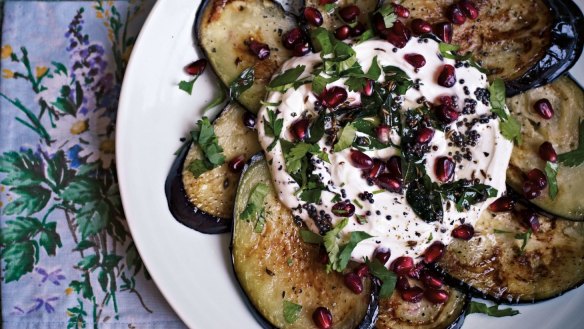
Crisp eggplants with sweet spiced yoghurt and pomegranates
In Hyderabad, they have a wonderful dish of pan-fried eggplants served with thick, spiced yoghurt. This dish was inspired by that one but done in a more modern way with slightly different spices. Add chickpeas to the spiced oil before tipping it into the yoghurt for extra protein, if you wish. Pomegranates add a burst of sweet, sour freshness but you can substitute halved baby tomatoes. Lastly, you can grill the eggplants instead of frying, it will still be lovely.
INGREDIENTS
For the eggplants
vegetable oil, to fry
2 smallish eggplants (300g–350g each),
sliced into 1cm-thick, long slices
good handful of pomegranate seeds
handful of chopped coriander leaves
For the yoghurt topping
1 tbsp vegetable oil
¾ tsp mustard seeds
¾ tsp cumin seeds
2 dried red chillies
12–14 curry leaves
250g Greek yoghurt
2 tsp castor sugar, or to taste
salt and freshly ground black pepper
METHOD
1. Pour about 1cm of oil in a large frying pan. Add as many eggplant slices as you can get in one layer and cook over a medium-high flame until golden on the base, around two to three minutes. Turn the slices and repeat. Place on two pieces of paper towel, then put in the oven to keep warm. Repeat with the remaining eggplant. (Alternatively, you can bake the eggplant slices in a preheated oven at 180C, spread out in one layer on a large baking tray, but they will not be as crisp.)
2. For the topping, heat the oil in a small saucepan. Add the mustard and cumin seeds, once they start to pop add the chillies and curry leaves and cook for a further 10 seconds or until cooked through. Pour into the yoghurt with the sugar and seasoning.
3. Place the eggplants on a large serving plate, slightly overlapping in a circular pattern. Spread the yoghurt over the central eggplants, leaving a large 7.5cm border. Garnish with the pomegranate seeds and coriander leaves and serve immediately.
Serves 4
This is an edited extract from Anjum's Indian Vegetarian Feast by Anjum Anand, published by Quadrille, $39.95
Appears in these collections
The best recipes from Australia's leading chefs straight to your inbox.
Sign up